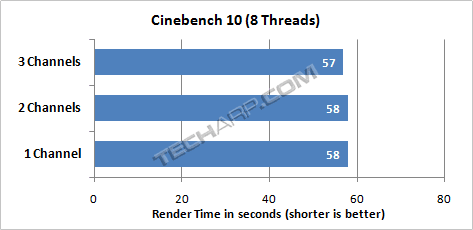The Intel Core i7 Memory Bandwidth
We have always advocated larger memory capacities over higher memory bandwidth to improve a PC's real-world performance. Note that we are talking about real-world performance here, not benchmark results. For us, what matters most is how fast we can really get the job done, rather than just some arbitrary number that shows you the maximum speed a component is capable of.
The effect of high memory bandwidth have always been overhyped by memory vendors, because it makes good business sense. Unfortunately, some tech writers have fallen into the same trap of reading too much into benchmark numbers and ignoring actual real-world performance. This is the situation we now see with the introduction of the new Intel Core i7 processor.
The Core i7 processor supports up to three DDR3 memory channels. That is an additional memory channel over what the industry is using now - dual memory channels. As some are fond of pointing out, 3 memory channels will automatically give 50 % more memory bandwidth over 2 memory channels even if everything else remains the same. Great, isn't it?
Using DDR3-1333 memory, triple-channels would give you a memory bandwidth of 64 GB/s. That is a tremendous amount of memory bandwidth. But do we really, really need that kind of bandwidth? That is what we will be looking at today.
Do Memory Channels Really Matter?
In these tests, we used the Intel Core i7-965 Extreme Edition running at 3.2 GHz. The L3 cache was set to run at 2.6 GHz. The DDR3 memory modules were set to run at 1066 MHz with timings of 7-7-7-20. Power Director 7 was used to convert 3 minutes of a HD video (1080), while Cinebench was set to use all 8 threads.
Power Director 7

Even with 50 % more memory bandwidth, Power Director 7 was just 9 seconds faster with 3 memory channels than it was with 2 memory channels. That's a completely negligible difference of 1 %.
Running with a single memory channel did result in a much longer render time. Power Director 7 took 84 seconds longer to complete the conversion. That's a difference of almost 11 %, compared to the conversion times with 2 or 3 memory channels.
Cinebench 10

Wow.. Even with all 4 cores fully occupied, increased memory bandwidth did not seem to help Cinebench render the scene any faster. Running with triple memory channels only speeded up the rendering by 1 second, which is completely insignificant.
Support Tech ARP!
If you like our work, you can help support out work by visiting our sponsors, participate in the Tech ARP Forums, or even donate to our fund. Any help you can render is greatly appreciated!
Page |
Topic |
||
1 |
|||
2 |







 Add to Reddit
Add to Reddit
